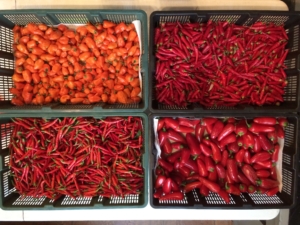 4th annual on Sat Oct 15, 10:00am-1:00pm at the South Hall
4th annual on Sat Oct 15, 10:00am-1:00pm at the South Hall
Shop for winter storage crops directly from LOCAL farmers IN BULK to fill your pantry for the winter. Load up on local root veggies, greens, cabbage, squash, apples, tomatoes, peppers, meats, fish, preserves and pickles. Last market of the season! Volunteers needed to help with set up and clean up.
CABLE BAY FARM, Retreat Cove
Galiano organically grown produce: Green and Red Peppers; bunches of Hakurei White Salad Turnips, Merlin & Cylindra Beets and Beet Greens
CLEARSKY FARMS
Garlic, winter squash, tomatillos, kale, bulk tomatoes, pole beans, black beans, and apples.
COUNTRY WOOLS, SIDNEY
Olde country sheep with pasture perfect lamb, including sausages. Eggs, squash, cascade berry vinaigrette.
DAISY HILL FARM, Galiano Island
Preserves, salsa, tomatoes.
DONNA MARBEN
Preserves, dried fruit, and fresh fruit and vegetables.
GALIANO COMMUNITY FOOD PROGRAM
Organic applesauce.
LAURIE MACCALLUM, Therah valley, Galiano Island
IOPA certified garlic.
SCHNARE, HYNICK, CROUSE & SONS {OCEANWISE SEAFOOD} – Captain Thomas Schnare
Fresh frozen Sockeye fillets; cold-smoked Albacore Tuna loins; Smoked Sockeye half-fillets; pre-sliced goldboard cold-smoked sockeye; thick-sliced ‘pounder’ smoked salmon bellies.
GALIANO SUNSHINE FARMS
Squash, potatoes, storage onions, hot peppers, broccoli, kale, apples, garlic and chard.
HOPE HILL FARM, Salt Spring Island
Whole frozen chicken, beef, winter squash, garlic, and sweet onions.
BECKY’S HOT FOOD available while you shop.
Spicy Jamaican patties (beef and veg.) samosas (beef, chicken, veg., and spinach), chicken wraps (with coconut milk base and spices), homemade Jamaican ginger beer, and ginger cookies. These products are available at wholesale, on order.
★ ★ ★ ★ ★ ★ ★ ★ ★ ★ ★ ★ ★ ★ ★ ★ ★ ★
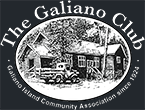
 4th annual on Sat Oct 15, 10:00am-1:00pm at the South Hall
4th annual on Sat Oct 15, 10:00am-1:00pm at the South Hall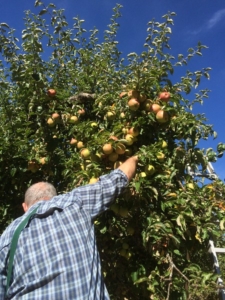 Another fruitful season of the Gleaning Project is drawing to a close. Every year I’m amazed at the generosity of this island, and the incredible bounty that we share. I feel so lucky to have this job since picking fruit outside with friends and neighbours is one of my all-time favourite activities. There really is nothing more beautiful than the sunlight coming through the leaves of an apple tree, and there is a special kind of zen to picking ripe fruit. And always the promise that the next one will be the biggest or the most perfect or the sweetest.
Another fruitful season of the Gleaning Project is drawing to a close. Every year I’m amazed at the generosity of this island, and the incredible bounty that we share. I feel so lucky to have this job since picking fruit outside with friends and neighbours is one of my all-time favourite activities. There really is nothing more beautiful than the sunlight coming through the leaves of an apple tree, and there is a special kind of zen to picking ripe fruit. And always the promise that the next one will be the biggest or the most perfect or the sweetest. Tug of war teams will start competing at 12:30pm
Tug of war teams will start competing at 12:30pm The Galiano Community School & Activity Centre, Sep 11, 12-4pm, rain or shine
The Galiano Community School & Activity Centre, Sep 11, 12-4pm, rain or shine Want to read and discuss writing on food, agriculture, sustainability, politics? Share insights, critique, explore, and discover? Read the book and join the discussion! See weekly Food Program newsletters for titles and meeting times.
Want to read and discuss writing on food, agriculture, sustainability, politics? Share insights, critique, explore, and discover? Read the book and join the discussion! See weekly Food Program newsletters for titles and meeting times. Community Games Night turns the South Hall into a giant family living room. Tables are set up with Scrabble and Battleship, Risk and Connect 4. There are decks of cards, and a Twister mat on the floor for the younger kids. It began as a way for the Food Program to hold an evening kitchen to stock the freezer with meals for seniors, but has since grown (as do so many of our food program ideas) into a much-loved monthly event.
Community Games Night turns the South Hall into a giant family living room. Tables are set up with Scrabble and Battleship, Risk and Connect 4. There are decks of cards, and a Twister mat on the floor for the younger kids. It began as a way for the Food Program to hold an evening kitchen to stock the freezer with meals for seniors, but has since grown (as do so many of our food program ideas) into a much-loved monthly event. Apiary Inspector David MacDonald will be coming to Galiano to share his knowledge on beekeeping, with specific focus on the varroa mite and its impact on honeybee populations. This course is for all levels of beekeepers, from novice to experienced, and will combine a morning tutorial with a field inspection at a local apiary. If you are interested, please RSVP to Colleen at galianofoodprograms@gmail.com. Details have not been confirmed but the course will likely run from 9am until 2pm. Entrance fee is by donation, a sliding scale of $10-15, with proceeds going to the Food Program.
Apiary Inspector David MacDonald will be coming to Galiano to share his knowledge on beekeeping, with specific focus on the varroa mite and its impact on honeybee populations. This course is for all levels of beekeepers, from novice to experienced, and will combine a morning tutorial with a field inspection at a local apiary. If you are interested, please RSVP to Colleen at galianofoodprograms@gmail.com. Details have not been confirmed but the course will likely run from 9am until 2pm. Entrance fee is by donation, a sliding scale of $10-15, with proceeds going to the Food Program.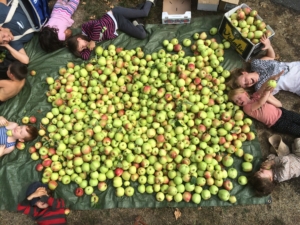 Are you a landowner with trees that are dripping with fruit, but you don’t have time to pick them? Is climbing a ladder getting to be too much? Did that one tree have a bumper crop this year? Do you have more than your family can use? Is your garden overflowing? Would you like to share the bounty with other members of the community? Would you benefit from access to healthy produce, but have no trees or garden of your own? Do you enjoy the simple pleasure of harvesting in a group?
Are you a landowner with trees that are dripping with fruit, but you don’t have time to pick them? Is climbing a ladder getting to be too much? Did that one tree have a bumper crop this year? Do you have more than your family can use? Is your garden overflowing? Would you like to share the bounty with other members of the community? Would you benefit from access to healthy produce, but have no trees or garden of your own? Do you enjoy the simple pleasure of harvesting in a group?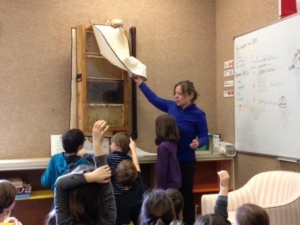 That March morning the school library was warm and smelled of cedar, beeswax. Weeks of anticipation–“When will they arrive?”–culminated. As two students and I approach the covered case, one student hyperventilates. “It’s ok,” I say. “The bees are behind glass.” We speak in hushed tones, overcome by rhythmic buzzing. I lift the cloth cover and we three exhale: ten-thousand pairs of wings shimmer on striped bodies.
That March morning the school library was warm and smelled of cedar, beeswax. Weeks of anticipation–“When will they arrive?”–culminated. As two students and I approach the covered case, one student hyperventilates. “It’s ok,” I say. “The bees are behind glass.” We speak in hushed tones, overcome by rhythmic buzzing. I lift the cloth cover and we three exhale: ten-thousand pairs of wings shimmer on striped bodies.